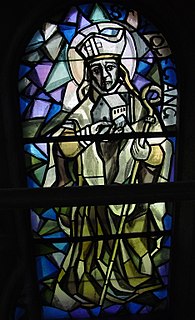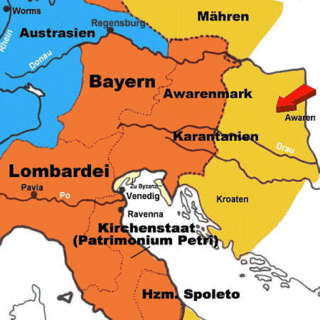
Arnulf of Carinthia was the duke of Carinthia who overthrew his uncle, Emperor Charles the Fat, became the Carolingian king of East Francia from 887, the disputed King of Italy from 894 and the disputed Holy Roman Emperor from February 22, 896 until his death at Regensburg, Bavaria.

Cyril and Methodius (815–885) were two brothers and Byzantine Christian theologians and missionaries. For their work evangelizing the Slavs, they are known as the "Apostles to the Slavs".

Year 828 (DCCCXXVIII) was a leap year starting on Wednesday of the Julian calendar.

The Prince-Archbishopric of Salzburg was an ecclesiastical principality and state of the Holy Roman Empire. It comprised the secular territory ruled by the archbishops of Salzburg, as distinguished from the much larger Catholic diocese founded in 739 by Saint Boniface in the German stem duchy of Bavaria. The capital of the archbishopric was Salzburg, the former Roman city of Iuvavum.

The Principality of Lower Pannonia, also known as the Balaton Principality, was an early medieval Slavic polity, situated in Lower Pannonia, with capital in Blatnograd. The polity was a vassal principality of the Frankish Empire, or according to others, a frontier county of the Eastern Frankish Kingdom. It was initially led by a dux (Pribina) and later by a comes (Kocel, Pribina's son, who was titled as "Count of the Slavs" .. It was one of the early Slavic polities, that emerged during the early medieval period. It was centered in western regions of modern Hungary, but also included some parts of modern Austria, Slovenia, Croatia and Serbia.

The Pericopes of Henry II is a luxurious medieval illuminated manuscript made for Henry II, the last Ottonian Holy Roman Emperor, made c. 1002 – 1012 AD. The manuscript, which is lavishly illuminated, is a product of the Liuthar circle of illuminators, who were working in the Benedictine Abbey of Reichenau, which housed a scriptorium and artists' workshop that has a claim to having been the largest and artistically most influential in Europe during the late 10th and early 11th centuries. An unrivalled series of liturgical manuscripts was produced at Reichenau under the highest patronage of Ottonian society.

Bavarians are an ethnographic group of Germans of the Bavaria region, a state within Germany. The group's dialect or speech is known as the Bavarian language, native to Altbayern, roughly the territory of the Electorate of Bavaria in the 17th century.

Saint Wolfgang of Regensburg was bishop of Regensburg in Bavaria from Christmas 972 until his death. He is a saint of the Roman Catholic and Eastern Orthodox churches. He is regarded as one of the three great German saints of the 10th century, the other two being Saint Ulrich of Augsburg and Saint Conrad of Constance. Towards the end of his life Wolfgang withdrew as a hermit to a solitary spot, in the Salzkammergut region of Upper Austria. Soon after Wolfgang's death many churches chose him as their patron saint, and various towns were named after him.

The Hildebrandslied is a heroic lay written in Old High German alliterative verse. It is the earliest poetic text in German, and it tells of the tragic encounter in battle between a father (Hildebrand) and a son (Hadubrand) who does not recognize him. It is the only surviving example in German of a genre which must have been important in the oral literature of the Germanic tribes.

The Bavarian State Library in Munich is the central "Landesbibliothek", i. e. the state library of the Free State of Bavaria, the biggest universal and research library in Germany and one of Europe's most important universal libraries. With its collections currently comprising around 10.89 million books, it ranks among the best research libraries worldwide. Moreover, its historical stock encompasses one of the most important manuscript collections of the world, the largest collection of incunabula worldwide, as well as numerous further important special collections.

Muspilli is an Old High German poem known in incomplete form from a ninth-century Bavarian manuscript. Its subject is the fate of the soul immediately after death and at the Last Judgment. Many aspects of the interpretation of the poem, including its title, remain controversial among scholars.

Pribina was a Slavic prince whose adventurous career, recorded in the Conversion of the Bavarians and the Carantanians, illustrates the political volatility of the Franco–Slavic frontiers of his time. Pribina was the first ruler of Slavic origin to build a Christian church on Slavic territory in Nitra, and also the first to accept baptism.

The Principality of Nitra, also known as the Duchy of Nitra, was a West Slavic polity encompassing a group of settlements that developed in the 9th century around Nitra in present-day Slovakia. Its history remains uncertain because of a lack of contemporary sources. The territory's status is subject to scholarly debate; some modern historians describe it as an independent polity that was annexed either around 833 or 870 by the Principality of Moravia, while others say that it was under influence of the neighbouring West Slavs from Moravia from its inception.

The Avar March was a southeastern frontier province of the Frankish Empire, established after successful Frankish campaigns and conquests of Avarian territories along the river Danube, to the east from the river Enns, in what is today Lower Austria and northwestern Hungary. Since the Frankish conquest in the late 8th century, there were several administrative changes in those regions. Territory along the river Danube, from the river Enns to the Vienna Woods, was ruled directly, as a frontier extension (march) of the Frankish Bavaria, while regions further to the east, up to the river Rába, were initially designated to remaining Avarian princes, under the Frankish supreme rule. During the 820s and 830s, additional administrative changes were made in the wider region of Frankish Pannonia, inhabited mainly by Slavs. Territories of the remaining Avarian princes were fully incorporated, and Avars eventually disappeared from the region.
The Aribonids were a noble family of probably Bavarian origin who rose to preeminence in the Carolingian March of Pannonia and the later Margraviate of Austria in the late ninth and early tenth centuries. The dynasty is named after its ancestor Margrave Aribo of Austria. The Aribonids maintained influence in the Duchy of Bavaria, the Austrian march, and other parts of Germany until the early twelfth century, when they disappear.

Modestus, called the Apostle of Carinthia or Apostle of Carantania, was most probably an Irish monk and the evangeliser of the Carantanians, an Alpine Slavic people settling in the south of present-day Austria and north-eastern Slovenia, who were among the ancestors of present-day Slovenes.
The Conversio Bagoariorum et Carantanorum is a Latin history written in Salzburg in the 870s. It describes the life and career of Salzburg's founding saint Rupert, notably his missionary work in Bavaria, and the activities of the bishops and abbots in the Archdiocese of Salzburg. It concludes with a brief history of Carantania.

The Archbishopric of Moravia was an ecclesiastical province, established by the Holy See to promote Christian missions among the Slavic peoples. Its first archbishop, the Byzantine Methodius, persuaded Pope John VIII to sanction the use of Old Church Slavonic in liturgy. Methodius had been consecrated archbishop of Pannonia by Pope Adrian II at the request of Koceľ, the Slavic ruler of Pannonia in East Francia in 870.
The timeline of Hungarian history lists the important historical events that took place in the territory of Hungary or are closely connected to the history of the country.
The history of Christianity in Hungary started in the Roman province of Pannonia, centuries before the arrival of the Magyars, or Hungarians.















